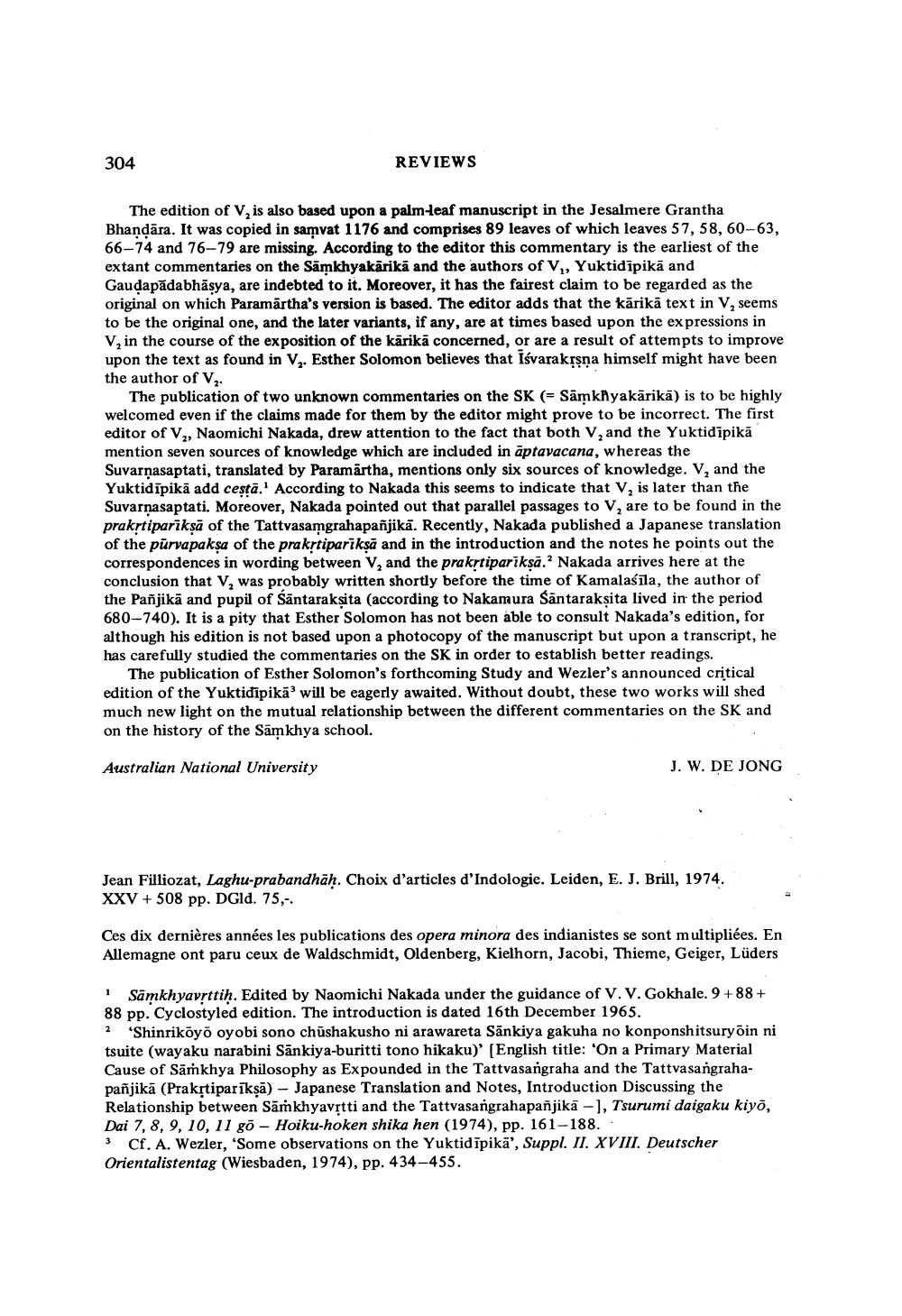Book Title: Reviews Of Different Books Author(s): J W De Jong Publisher: J W De Jong View full book textPage 8
________________ 304 REVIEWS The edition of V, is also based upon a palm-teaf manuscript in the Jesalmere Grantha Bhandāra. It was copied in samvat 1176 and comprises 89 leaves of which leaves 57, 58, 60-63, 66-74 and 76-79 are missing. According to the editor this commentary is the earliest of the extant commentaries on the Samkhyakārika and the authors of V, Yuktidipikā and Gaudapădabhāsya, are indebted to it. Moreover, it has the fairest claim to be regarded as the original on which Paramartha's version is based. The editor adds that the kārikā text in V, seems to be the original one, and the later variants, if any, are at times based upon the expressions in V, in the course of the exposition of the kärikā concerned, or are a result of attempts to improve upon the text as found in V. Esther Solomon believes that Isvarakrsna himself might have been the author of Vz The publication of two unknown commentaries on the SK (Sāmkhyakārikā) is to be highly welcomed even if the claims made for them by the editor might prove to be incorrect. The first editor of V2, Naomichi Nakada, drew attention to the fact that both V, and the Yuktidīpikā mention seven sources of knowledge which are included in aptavacana, whereas the Suvarnasaptati, translated by Paramartha, mentions only six sources of knowledge. V, and the Yuktidīpikā add cestā.' According to Nakada this seems to indicate that V, is later than the Suvarnasaptati. Moreover, Nakada pointed out that parallel passages to V, are to be found in the prakstiparīksā of the Tattvasamgrahapañjikā. Recently, Nakada published a Japanese translation of the pūrvapaksa of the prakrtipariksā and in the introduction and the notes he points out the correspondences in wording between V, and the prakrtipariksa.Nakada arrives here at the conclusion that V, was probably written shortly before the time of Kamalaśīla, the author of the Pañjikā and pupil of Säntaraksita (according to Nakamura Säntaraksita lived in the period 680-740). It is a pity that Esther Solomon has not been able to consult Nakada's edition, for although his edition is not based upon a photocopy of the manuscript but upon a transcript, he has carefully studied the commentaries on the SK in order to establish better readings. The publication of Esther Solomon's forthcoming Study and Wezler's announced critical edition of the Yuktidipika' will be eagerly awaited. Without doubt, these two works will shed much new light on the mutual relationship between the different commentaries on the SK and on the history of the Sāmkhya school. Australian National University J. W. DE JONG Jean Filliozat, Laghu-prabandhāḥ. Choix d'articles d'Indologie. Leiden, E. J. Brill, 1974. XXV + 508 pp. DGid. 75,-- Ces dix dernières années les publications des opera minora des indianistes se sont multipliées. En Allemagne ont paru ceux de Waldschmidt, Oldenberg, Kielhorn, Jacobi, Thieme, Geiger, Lüders 1 Samkhyavrttih. Edited by Naomichi Nakada under the guidance of V. V. Gokhale. 9+88+ 88 pp. Cyclostyled edition. The introduction is dated 16th December 1965. 2 'Shinriköyö oyobi sono chushakusho ni arawareta Sänkiya gakuha no konponshitsuryõin ni tsuite (wayaku narabini Sānkiya-buritti tono hikaku)' (English title: 'On a Primary Material Cause of Sārkhya Philosophy as Expounded in the Tattvasangraha and the Tattvasangrahapanjikā (Prakrtiparīksā) - Japanese Translation and Notes, Introduction Discussing the Relationship between Sāṁkhyavrtti and the Tattvasangrahapañjikā -1, Tsurumi daigaku kiyo, Dai 7, 8, 9, 10, 11 go - Hoiku-hoken shika hen (1974), pp. 161-188. 3 Cf. A. Wezler, 'Some observations on the Yuktidīpikā', Suppl. II. XVIII. Deutscher Orientalistentag (Wiesbaden, 1974), pp. 434-455.Page Navigation
1 ... 6 7 8 9 10 11 12 13 14 15 16 17 18 19 20 21 22 23 24 25 26 27 28 29 30 31 32
